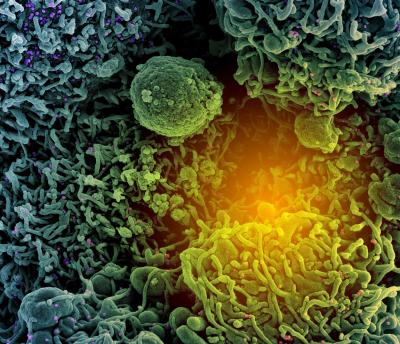NIAID Mouse Study Shows Benefits of COVID-19 Nasal Vaccine vs. Intramuscular
When the first COVID-19 vaccines became widely available in the United States in early 2021, using new messenger RNA (mRNA) technology to combat disease-causing SARS-CoV-2, scientists continued their work to further improve and diversify vaccine options. Experimental nasal vaccines – think FluMist – are the latest COVID-19 candidates to receive attention through published preclinical studies highlighting their advantages. Currently, all COVID-19 vaccines available in the U.S. must be delivered into a muscle, typically in the shoulder.
A new comparison study in PNAS from NIAID intramural scientists clearly shows that for SARS-CoV-2, nasal vaccination – particularly in two doses – has clear advantages over muscular delivery in laboratory mice. The vaccine tested uses an old immune-activation concept: modified vaccinia virus Ankara (MVA), which is a licensed smallpox and monkeypox vaccine, and is being actively pursued as a vector, or carrier, to deliver a viral protein for other infectious diseases. For this vaccine candidate, the MVA vector delivers the spike protein of SARS-CoV-2, which sits on the surface of the virus, to spur an immune response.
Advantages of the nasal MVA-based vaccine include:
- Virus targeting: SARS-CoV-2 initially establishes infection in the nose and throat before spreading to the lungs. Within six hours of delivery, scientists observed the nasal vaccine working in all the key areas, remaining active for three days. The vaccine delivered to the muscle remained in place, generating a slow immune response only to the lung region and blood.
- Broad protection: The nasal vaccine quickly generated a variety of protective immune responses, including antibodies A and G. The muscular vaccine only generated type G antibodies, and mainly in the lungs. Type A antibodies are important protectors against SARS-CoV-2 because they are found in the mouth and in saliva – places where the virus wants to establish. Both vaccines also generated white blood cells (T cells), but in significantly higher levels via the nasal vaccine.
- Rapid protection: Nasal vaccination either prevented or accelerated SARS-CoV-2 elimination in nasal passages and lungs as early as two days after exposure to the virus. This likely was because of the type A antibodies at work, the scientists say. Muscular vaccination was less effective, preventing death and clearing virus from the respiratory tract, but over several days and not protecting nasal passages.
Both the nasal and muscular vaccines were durable, maintaining neutralizing levels of antibodies against SARS-CoV-2 for more than six months; the antibodies neutralized the initial virus strain and the Beta and Omicron variants, although to a lesser extent. Potency waned at a rate of about 20 percent per month, consistent with what researchers have observed with mRNA COVID-19 vaccines. Although the study did not explore the vaccine’s ability to halt virus transmission, scientists theorize that a vaccine that can prevent or quickly eliminate virus in nasal passages would likely reduce the likelihood of person-to-person transmission.
Laboratory work is continuing on the effectiveness of this approach for highly transmissible SARS-CoV-2 variants, including Omicron. These studies support clinical testing of upper respiratory delivery of COVID-19 vaccines.
References:
J Americo et al. Intranasal inoculation of an MVA-based vaccine induces IgA and protects the respiratory tract of hACE2 mice from SARS-CoV-2 infection. PNAS. DOI: 10.1073/pnas.2202069119 (2022).
R Liu et al. One or two injections of MVA-vectored vaccine shields hACE2 transgenic mice from SARS-CoV-2 upper and lower respiratory tract infection. PNAS. (2021).
B Bosnjak, et al. Intranasal Delivery of MVA Vector Vaccine Induces Effective Pulmonary Immunity Against SARS-CoV-2 in Rodents. Frontiers in Immunology. (2021)
A Hassan, et al. An intranasal vaccine durably protects against SARS-CoV-2 variants in mice. Cell Reports. (2021).


